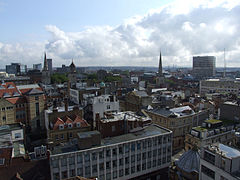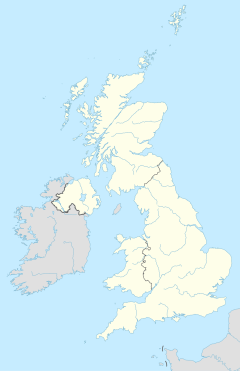Bristol City Centre
This article needs additional citations for verification. (January 2009) |
| Bristol City Centre | |
|---|---|
| Central Business District | |
 Roofscape of central Bristol | |
Location within the United Kingdom | |
| Unitary authority |
|
| Country | England |
| Sovereign state | United Kingdom |
| Post town | BRISTOL |
| Postcode district | BS1, BS8 |
| Dialling code | 0117 |
| UK Parliament | |
Bristol City Centre is the commercial, cultural and business centre of Bristol, England. It is the area north of the New Cut of the River Avon, bounded by Clifton Wood and Clifton to the north-west, Kingsdown and Cotham to the north, and St Pauls, Lawrence Hill and St Phillip's Marsh to the east. The Bristol Royal Infirmary, Bristol Royal Hospital for Children, the BBC, the main campus of the University of Bristol, the Crown and Magistrate's Courts, Temple Meads railway station, Bristol bus station, the Park Street, Broadmead and Cabot Circus shopping areas together with numerous music venues, theatres and restaurants are located in this area. The area consists of the council wards of Central, Hotwells & Harbourside, and part of Lawrence Hill.[1]
Historic centre
[edit]The mediaeval heart of the city was immediately north of Bristol Bridge, between the River Frome and the River Avon, at the High Cross where the four cross streets High Street, Wine Street, Broad Street and Corn Street meet. The traditional view that this was also the Saxon centre was challenged in the 1970s by archaeology suggesting that Bristol's origins lay to the east of High Street in the area that is now Castle Park, but more recent Saxon finds around Small Street favour the earlier view.[2][3]
This was Bristol's pre-war central shopping district, a knot of ancient narrow streets including Wine Street, Mary le Port Street and Castle Street, which was severely damaged in 1940 during the Bristol Blitz.[4] The area to the north and west of Castle Park, around Broad Street, Corn Street and St Nicholas Market largely survived, and contains many historic buildings.
The Centre
[edit]The course of the River Frome, immediately to the west of the historic centre, was covered over in stages, in the second half of the 19th century. The area became the hub of the city's tramway network, and was known as the Tramways Centre.[5] It was so called long after the last trams left in 1941, but is now known simply as The Centre.
Between 1936 and 1938, the Centre was enlarged when more of the River Frome, between Broad Quay and St Augustine's Parade, was covered in, making way for the Inner Circuit Road.[6] The western side of the Inner Circuit Road has since been largely decommissioned, and recent works have rebalanced The Centre in favour of pedestrians, cyclists and public transport users.[7]
Broadmead
[edit]The area northeast of the historic area, around Broadmead, was redeveloped after the war despite overwhelming public opinion against it, and the streets and shops in Broadmead became the main shopping district of the city.[8] Like many 1950s buildings in Britain, affordable but architecturally uninteresting utilitarian buildings form the bulk of the Broadmead area.
In the 1980s, some of these were demolished to make way for the Galleries shopping centre, which is a three level covered street. In 2008, the shopping area was extended over the central ring road to produce a new shopping centre, Cabot Circus, which opened in September 2008.
Harbourside
[edit]The City Docks were immediately south of the Centre. Although most ships used Avonmouth Docks after the Royal Edward Dock was opened in 1908, ocean-going ships were regularly seen at the Centre until the 1960s. In 1972 the Royal Portbury Dock was opened, and the City Docks were closed. The harbour buildings, including the tobacco warehouses, became redundant.
The harbourside has been regenerated in the 1990s and 2000s, with the refurbishment of warehouses as bars, restaurants, the Watershed Media Centre and the Arnolfini art gallery, as well as the creation of the At-Bristol science centre (later rebranded as We the Curious).
Gallery
[edit]-
The channelled River Avon (the Floating Harbour) flows through the city centre; most of the central part of the City of Bristol is shown here
-
The Centre, seen from the bottom of Park Street
-
The North Entrance to the Galleries Shopping Centre, Broadmead
-
St. Augustine's Reach, Bristol Harbour
-
Radisson Blu Hotel and Broad Quay Serviced Apartments, The Centre
-
Corn Street, heart of the Old City
-
Hammerbeam roof in the Great Hall of the Wills Memorial Building, University of Bristol
-
BBC Bristol TV Studios, Whiteladies Road
-
Sculpture outside Bristol Children's Hospital
-
Crown Court, Small Street
-
Booking Office, Temple Meads Station
-
Bristol Bus Station
-
Park Street and Wills Memorial Building
References
[edit]- ^ "Bristol Local Plan". Bristol City Council. Retrieved 27 April 2018.
- ^ Watts, Lorna; Rahtz, Philip (1985). Mary-le-Port Bristol Excavations 1962/3. City of Bristol Museums and Art Gallery. ISBN 0-900199-26-1.
- ^ Foyle, Andrew (2004). "Introduction". Pevsner Architectural Guides: Bristol. Yale University Press. ISBN 0-300-10442-1.
- ^ Hasegawa, Junichi (1992). "6 Replanning the city centre: Bristol 1940-45". Replanning the blitzed city centre. Open University Press. ISBN 0-335-15633-9.
- ^ Appleby, John B (1969). Bristol's Trams Remembered. J.B. Appleby.
- ^ Winstone, Reece (1983). "plates 30, 31". Bristol as it Was 1939-1914. Reece Winstone. ISBN 0-900814-54-3.
- ^ "New Bristol city centre road layout opens to traffic". BBC News. 2 April 2017. Retrieved 13 April 2017.
- ^ Hasegawa, Junichi (1992). "7 City planning in the immediate aftermath of war: 1946". Replanning the blitzed city centre. Open University Press. ISBN 0-335-15633-9.















